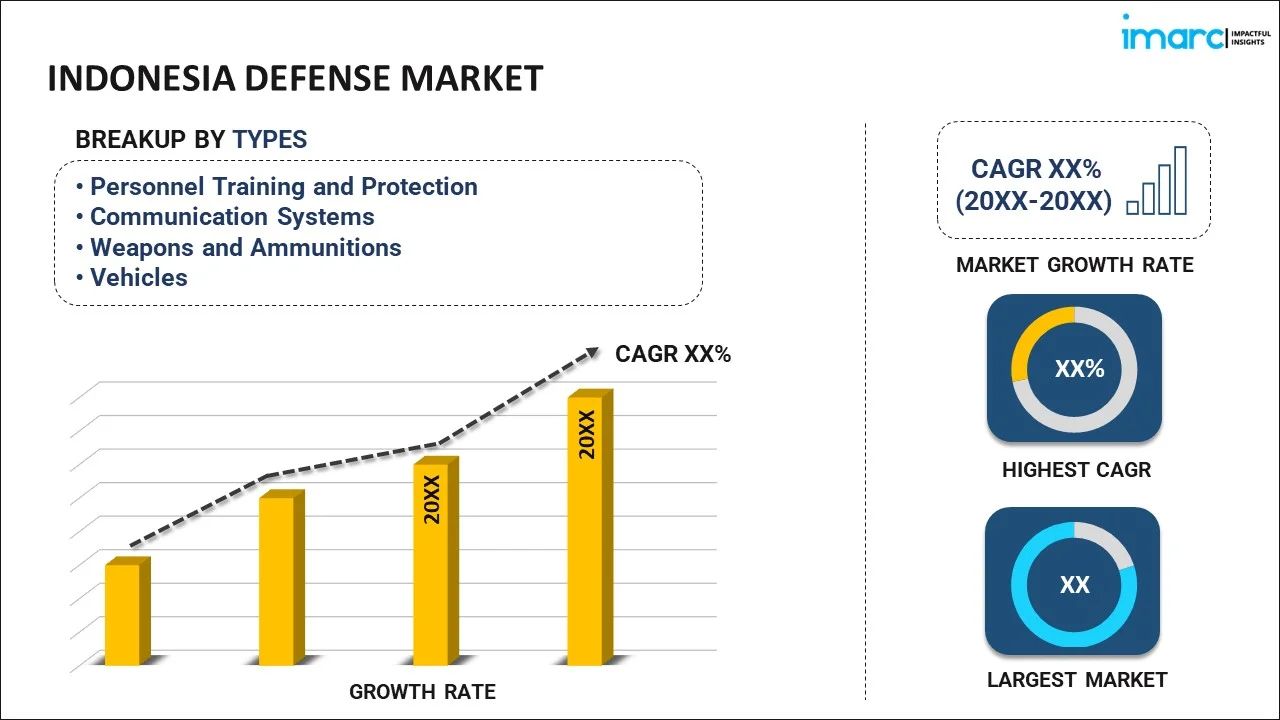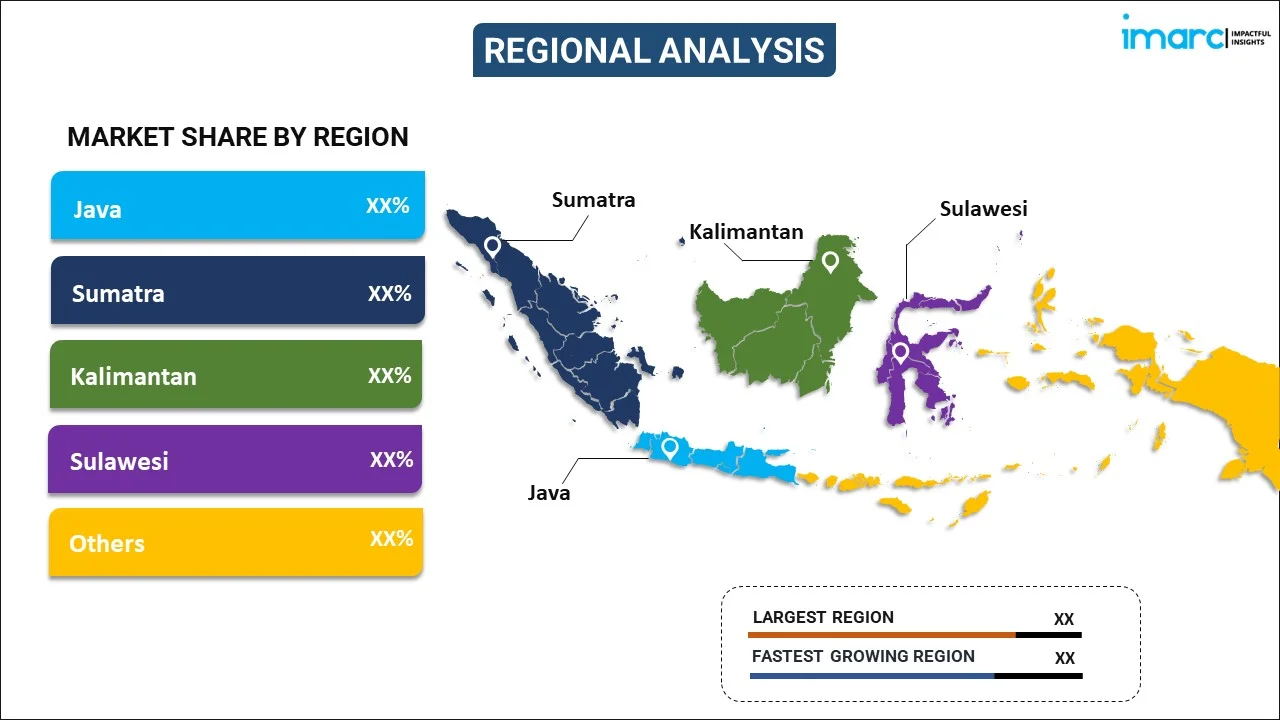
Indonesia Defense Market Report by Type (Personnel Training and Protection, Communication Systems, Weapons and Ammunitions, Vehicles), and Region 2024-2032
Market Overview:
Indonesia defense market size is projected to exhibit a growth rate (CAGR) of 2.97% during 2024-2032. Heightening regional geopolitical tensions, the need for maritime security, cybersecurity concerns, economic growth, and a commitment to modernizing and expanding the nation's defense capabilities represent some of the key factors driving the market.
|
Report Attribute
|
Key Statistics
|
|---|---|
|
Base Year
|
2023 |
|
Forecast Years
|
2024-2032
|
|
Historical Years
|
2018-2023
|
| Market Growth Rate (2024-2032) | 2.97% |
Defense refers to a category of goods and services designed to protect individuals, organizations, and nations from various threats, risks, and adversities. This sector encompasses a broad spectrum of offerings, spanning from physical security solutions, such as armored vehicles, surveillance systems, and bulletproof clothing, to advanced cybersecurity software and military hardware. Defense products often serve the purpose of safeguarding against a wide array of perils, including physical violence, cyberattacks, espionage, natural disasters, and even economic downturns. They are primarily associated with military equipment and technologies, including fighter jets, warships, armored tanks, and advanced weaponry. These items are designed to deter potential aggressors, maintain peace, and ensure the protection of a country's sovereignty. Defense products extend beyond military applications, finding their place in the commercial and individual sectors, where they offer solutions for personal safety, critical infrastructure protection, and cybersecurity.
Indonesia Defense Market Trends:
The archipelagic nature of Indonesia, comprising over several thousand islands, creates a compelling need for maritime security and coastal defense solutions. The country's extensive coastline faces various security threats that necessitate investments in naval vessels, surveillance systems, and port security infrastructure, creating a favorable outlook for market expansion. Besides this, rising geopolitical tensions and territorial disputes in Southeast Asia have led to an increased focus on national defense, resulting in Indonesia's continuous effort to modernize its armed forces, prompting acquisitions of advanced weaponry and defense systems to maintain a robust military presence in the region. Moreover, the global proliferation of terrorism and transnational threats has prompted Indonesia to enhance its counter-terrorism capabilities by investing in intelligence, surveillance, and reconnaissance (ISR) technologies, as well as specialized counter-terrorism units, thereby strengthening the market growth. Concurrent with this, cybersecurity concerns have gained prominence in Indonesia, with the escalating frequency and sophistication of cyberattacks. Consequently, there is a growing demand for cybersecurity solutions to protect critical infrastructure, government networks, and sensitive data, which is contributing to the growth of the defense market. Additionally, Indonesia's economic growth and burgeoning middle class have boosted the country's defense budget, allowing for more substantial investments in defense capabilities, which is providing an impetus to the market growth. Apart from this, Indonesia's ambitions to become a regional military power have led to greater emphasis on research and development (R&D) in defense industries, aiming to reduce reliance on foreign imports, thus aiding in market expansion.
Indonesia Defense Market Segmentation:
IMARC Group provides an analysis of the key trends in each segment of the market, along with forecasts at the country level for 2024-2032. Our report has categorized the market based on type.
Type Insights:

- Personnel Training and Protection
- Communication Systems
- Weapons and Ammunitions
- Artillery and Mortar Systems
- Infantry Weapons
- Missile and Missile Defense Systems
- Ammunitions
- Vehicles
- Land-based Vehicles
- Sea-based Vehicles
- Air-based Vehicles
The report has provided a detailed breakup and analysis of the market based on the type. This includes personnel training and protection, communication systems, weapons and ammunitions (artillery and mortar systems, infantry weapons, missile and missile defense systems, and ammunitions), and vehicles (land-based vehicles, sea-based vehicles, and air-based vehicles).
Regional Insights:

- Java
- Sumatra
- Kalimantan
- Sulawesi
- Others
The report has also provided a comprehensive analysis of all the major regional markets, which include Java, Sumatra, Kalimantan, Sulawesi, and Others.
Competitive Landscape:
The market research report has also provided a comprehensive analysis of the competitive landscape in the market. Competitive analysis such as market structure, key player positioning, top winning strategies, competitive dashboard, and company evaluation quadrant has been covered in the report. Also, detailed profiles of all major companies have been provided.
Indonesia Defense Market Report Coverage:
| Report Features | Details |
|---|---|
| Base Year of the Analysis | 2023 |
| Historical Period | 2018-2023 |
| Forecast Period | 2024-2032 |
| Units | US$ Million |
| Scope of the Report | Exploration of Historical Trends and Market Outlook, Industry Catalysts and Challenges, Segment-Wise Historical and Future Market Assessment:
|
| Types Covered |
|
| Regions Covered | Java, Sumatra, Kalimantan, Sulawesi, Others |
| Customization Scope | 10% Free Customization |
| Report Price and Purchase Option | Single User License: US$ 3699 Five User License: US$ 4699 Corporate License: US$ 5699 |
| Post-Sale Analyst Support | 10-12 Weeks |
| Delivery Format | PDF and Excel through Email (We can also provide the editable version of the report in PPT/Word format on special request) |
Key Questions Answered in This Report:
- How has the Indonesia defense market performed so far and how will it perform in the coming years?
- What has been the impact of COVID-19 on the Indonesia defense market?
- What is the breakup of the Indonesia defense market on the basis of type?
- What are the various stages in the value chain of the Indonesia defense market?
- What are the key driving factors and challenges in the Indonesia defense?
- What is the structure of the Indonesia defense market and who are the key players?
- What is the degree of competition in the Indonesia defense market?
Key Benefits for Stakeholders:
- IMARC’s industry report offers a comprehensive quantitative analysis of various market segments, historical and current market trends, market forecasts, and dynamics of the Indonesia defense market from 2018-2032.
- The research report provides the latest information on the market drivers, challenges, and opportunities in the Indonesia defense market.
- Porter's five forces analysis assist stakeholders in assessing the impact of new entrants, competitive rivalry, supplier power, buyer power, and the threat of substitution. It helps stakeholders to analyze the level of competition within the Indonesia defense industry and its attractiveness.
- Competitive landscape allows stakeholders to understand their competitive environment and provides an insight into the current positions of key players in the market.
Need more help?
- Speak to our experienced analysts for insights on the current market scenarios.
- Include additional segments and countries to customize the report as per your requirement.
- Gain an unparalleled competitive advantage in your domain by understanding how to utilize the report and positively impacting your operations and revenue.
- For further assistance, please connect with our analysts.
 Inquire Before Buying
Inquire Before Buying
 Speak to an Analyst
Speak to an Analyst
 Request Brochure
Request Brochure
 Request Customization
Request Customization




.webp)




.webp)












